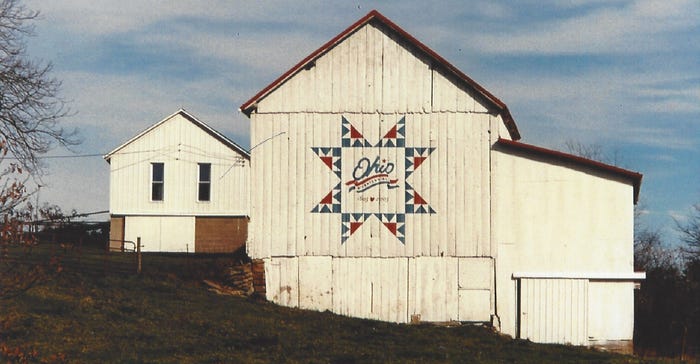December 15, 2020

Quilt barns are a way of paying homage to the generations of men and women who have come before. Trekking into the wilderness to establish a new life, master barn builders employed the art of timber framing to build the historic barns that stored feed and sheltered livestock.
This was the man’s domain to provide for his family. Quilt blocks represent the art of quilting and the woman’s world of caring for the house, feeding and clothing the family. Together, they tell many stories of families and communities.
Quilt barns were first spotted in Kentucky and Tennessee. But it was Ohio that took the idea and ran with it, evolving it into quilt barn trails.
Donna Sue Groves of Adams County had a dream to honor her mother, Maxine, and her mother’s passion for quilting by painting a favorite quilt block on the side of their barn. From that small seed, the quilt trails concept was conceived and bloomed across the state.
Groves became the driving force behind this concept and created the first Quilt Barn Trail in Adams County. The celebration of local history became a way to bring tourism into the area and help the local economy.
Word began to spread, and soon, Brown County and others wanted in on the action. Thirty-eight of Ohio’s 88 counties have driving tours. Brochures and websites provide maps, directions, pictures and stories on each quilt barn trail.
Most trails are started with 20 barns, the number of blocks in an average quilt. Each family wishing to participate chooses their own quilt block design. Some are very old patterns remembered from grandmother’s quilting, and some are new designs to reflect the present.
Early days
The first quilt blocks were painted directly on the barn siding, giving the designs an added texture. Soon it became apparent it would be easier to paint two 4-by-8 sheets of plywood and mount the finished 8-by-8-foot quilt block on the barn.
There is no better way to see and enjoy the beautiful countryside of Ohio than by exploring the many different quilt barn trails. Pack a picnic and a camera, load the family in the car and take a day trip.
Here are just a few of the counties with quilt barn trails:
Tuscarawas and Greene counties have 4-H Quilt Square trails created exclusively by 4-H clubs in their respective counties.
Fayette, Highland and Ross counties have banded together to develop the tri-county Paint Creek Patterns Trail.
Patchwork Path is a trail in Athens County and has a choice of three different loops to explore.
Heritage Quilt Trail in Coshocton County focuses on local history with old family quilt patterns.
Hancock County has at least one quilt barn in each of its 17 townships.
Patchwork Trails in Lorain County displays patterns with political, patriotic and historical themes.
Pike’s Patches Quilt Barn Trail in Pike County features patterns from family quilts.
A Stitch in Time Quilt Trail of Vinton County will please both quilters and barn enthusiasts.
Quilt blocks are not only found on barns, but they also can be seen on businesses, garages and other structures. Quilt Block Square of Carroll County is such a place. Its quilt blocks are spread throughout the downtown area.
These wonderful trails are a great way to get out and escape cabin fever. For a list of counties in Ohio with quilt block trails, visit barnquiltinfo.com. Then contact the county’s tourism board to obtain a map of the trail.
For more on quilt block trails across the nation, read "Barn Quilts and the American Quilt Trail Movement" by Suzi Parron and Donna Sue Groves.
Contact Pamela Whitney Gray, the “lady barn consultant,” with other interesting barn stories at [email protected] or 740-263-1369.
About the Author(s)
You May Also Like




